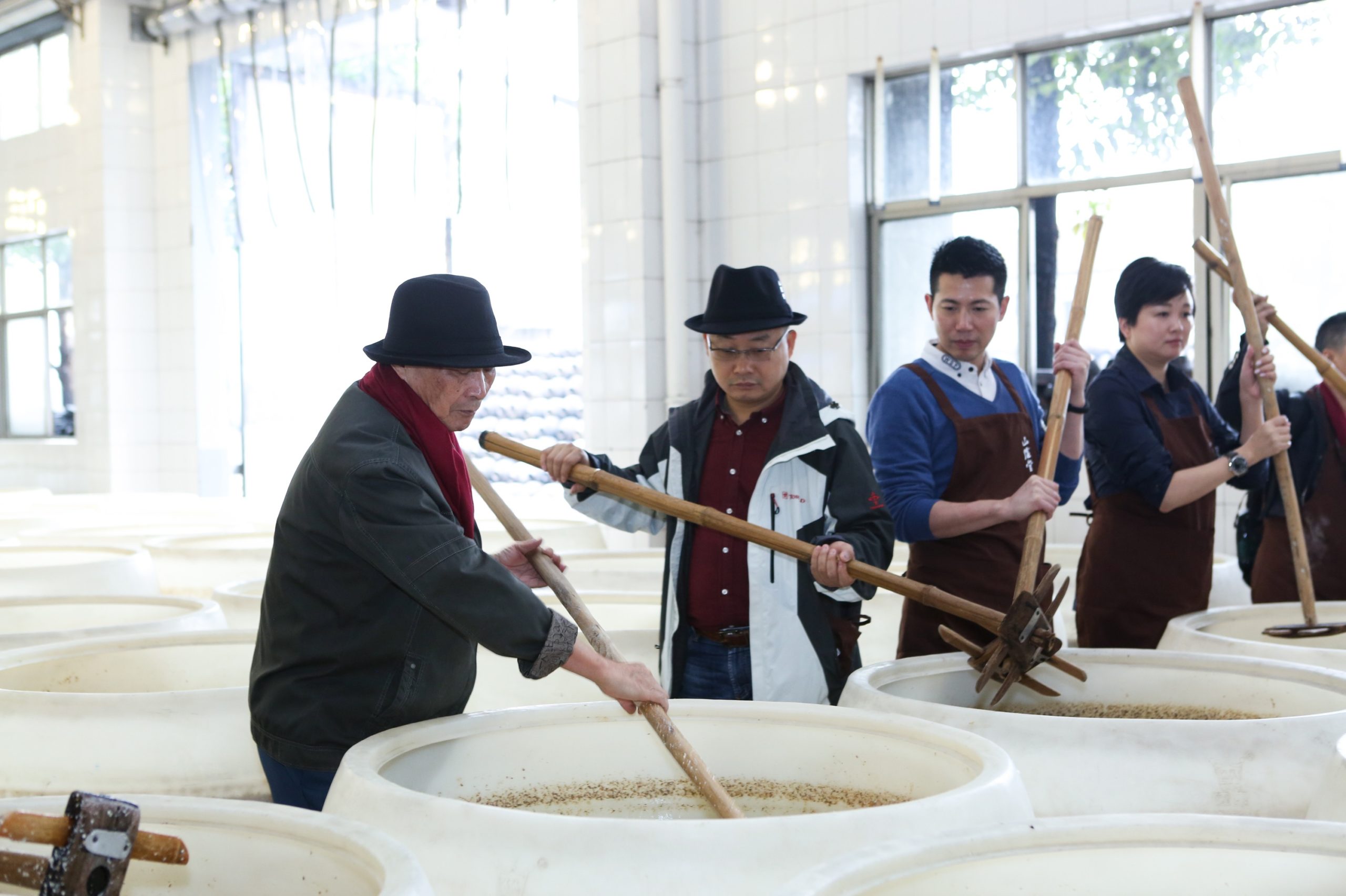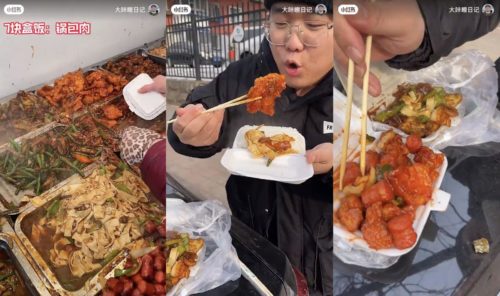Nü Er Hong: How a rice winemaker created a legendary Chinese brand
Jin Fangcai rose out of family tragedy to become the "soul of Chinese wine." His story is one of perseverance and passion — and plain ol’ business smarts.

Jīn Fāngcái 金芳才 stands up from his armchair and walks to the far end of his 30-square-meter, dimly lit cottage. The room smells of dust and fermented food. He opens a bottle of rice wine and pours gently into a porcelain cup, its content a sparkling brownish hue in the sunlight.
In his blue work outfit, Jin, 81, might come across as a pensioner. But then he lays his gnarled hand on a jar of rice wine, and you know he has a story to tell — that of a 60-year fascination with a quintessential Chinese alcohol.
In Shaoxing, young winemakers attempt to revive China’s original spirit
Jin is a rice wine virtuoso in eastern China’s Shaoxing region in Zhejiang province. But unlike other dedicated craftsmen in the profession, he was a pioneer in branding before the concept gained traction in the 1990s. Among his numerous feats is the creation of Nǚ Ér Hóng 女儿红, widely recognized as the cream of rice wine and celebrated in literary works, movies, and folklore.
But his path to success was a rocky one, including tragedy during the Cultural Revolution and a prolonged fight for the right to use the “Nü Er Hong” name.
A childhood wrecked by political chaos
Born in 1940 to a father who was the second-generation owner of a family-run winery called Jīn Fù Xīng 金复兴, Jin grew up in Dongguan, a township of Shangyu that is now a district-level city within the jurisdiction of Shaoxing. “When other kids were running amok in the fields after school, I began to acquire fermentation techniques under my father,” Jin says.
He was groomed to take over the winery, but his formal initiation came after a family tragedy.
In a strategic move to transform private firms into quasi-state-owned enterprises, the central government rolled out the system of “joint public-private ownership” in 1954. The Jins’ winery, which was founded in 1919, was subject to a “nationalization” campaign, with Jin Sr. remaining in his role as director overseeing production. When a batch of wine went sour in June 1955, he was scapegoated and ruthlessly criticized. An otherwise common mishap brought misfortune at a time of scarcity: waste of grain assigned exclusively for winemaking constituted a political mistake.
Bombarded with vitriol, Jin Sr. father hanged himself inside the winery. He was survived by a wife and six children.
Life was harsh for a family that had lost its breadwinner. As a form of compensation of sorts, Jin Fangcai, the eldest son who was barely 15, was given an apprenticeship in what used to be the family winery. “I did everything, from fetching water and rinsing clay jars to moving empty jars about the factory floor,” Jin says.
On a typical workday, he would paddle his tarpaulin-canopied boat — called a wūpéngchuán 乌篷船 — across the waterways crisscrossing Shaoxing. He rowed down a river to larger lakes and made his way back with buckets filled with water suitable for winemaking. “After a day’s work, you were bone-tired,” he says.
Before the advent of stainless steel fermentation tanks and cooling systems, winemaking was purely manual and depended heavily on the experience of winemakers working in often primitive conditions. A seasoned maker, usually male, would press his ear against a large vat to check on the fermentation, listening to the bubbling sound caused by the yeast’s consumption of sugars in the rice. About eight to 10 hours later, he would open the lid and stir the rice mash with a long hoe-shaped wooden pole, a procedure known as kāipá 开耙 that would be repeated every four to five hours. This is to dissipate the heat trapped in the mash and allow oxygen in so that the yeast can continue breaking down sugars into alcohol and carbon dioxide at a more controlled pace.
Wine easily gets sour or bitter if the stirring isn’t done properly. Therefore, kaipa skills are the most prized in winemaking. “As the person responsible for the end product’s quality, I was under great pressure. If I messed up, punishment would follow,” Jin says. “Never could I put my mind at ease.”
But in an age when a “correct” upbringing mattered more than expertise, the highest position Jin could attain was head of production. His identity as the son of a “capitalist roader” held him back.

Jin’s personal and family destiny did not take a turn for the better until Dèng Xiǎopíng 邓小平 came to power in 1978. A large number of individuals wrongly convicted, persecuted, or smeared during the political movements of the previous two decades were rehabilitated. Among them was Jin’s father.
Once the political straitjackets were removed, Jin’s talent bloomed. In 1981, he participated in a national competition that included established industry leaders such as Gǔyuè Lóngshān 古越龙山 and Kuàijīshān 会稽山. What drove him to participate in the contest was a belief that, as he puts it, “wines from my hometown (of Shangyu) are just as good as peers from Shaoxing proper.”
Throughout history, wines from Shangyu had been viewed as inferior and unauthentic. As part of an administrative overhaul, they were even barred from using the label “Made in Shaoxing,” a policy that dented sales. Jin took this personally and felt he had something to prove, both for himself and for his hometown.
Jin’s wine, which took him five years to brew, won. The victory made him a household name among winemakers. And that’s when he began to think bigger.
The origins of a legendary brand
In a small eatery in Dongguan where he has been recounting his life story, diners who know Jin stop from time to time to greet him in the local dialect.
“These are my former subordinates at the Nü Er Hong Winery,” says the octogenarian. He is well known around these parts. As deputy general manager and then Party chief of the winery, Jin presided over its ascent. In 1983, he even became a member of Shaoxing’s first Political Consultative Conference, China’s political advisory body.
For the uninitiated, if yellow rice wine is an icon of Shaoxing in eastern China, Nü Er Hong — named after a folk tradition — can be regarded as its crown jewel. In Shaoxing, a customary practice for a man with a newborn daughter is to make a jar of rice wine and store it in a wall. On the day of the daughter’s marriage, he breaks the wall and retrieves the well-aged wine. The wine is then loaded, as part of the daughter’s dowry, onto her palanquin bound for the bridegroom’s place.
This matrimonial wine is known historically as Nǚ Ér Jiǔ (女儿酒, or “daughter’s wine”), and represents the father’s deepest love for his daughter.

In the early 1980s, when market reforms were only beginning to take hold on the mainland, Hong Kong was already a prospering metropolis. However, for residents there who originally hailed from Shanghai or the provinces of Zhejiang and Jiangsu, a sense of nostalgia was growing for the food and drink of their native homes. Louis Cha’s popular wǔxiá 武侠 novels feature a line that makes reference to rice wine: “Waiter, serve me a pot of good Nü Er Hong.”
Louis Cha, (1924-2018, 查良镛 Chá Liángyōng), known by the pen name Jīn Yōng 金庸, wrote China’s most popular martial arts novels. His mention of Nü Er Hong piqued the curiosity of those in Hong Kong. Nü Er Hong was also the drink with which Tung Chee-hwa (董建华 Dǒng Jiànhuá), the first Chief Executive of Hong Kong, celebrated his appointment in front of reporters in January 1997.
As word spread to the mainland, especially to the birthplace of this “daughter’s wine,” a handful of shrewd winemakers sensed an opportunity. Wineries in Shaoxing, large and small, started labeling their goods as Nü Er Hong, saturating the market with lookalikes of wildly different quality.
“If one winery registered a trademark for Nü Er Hong, the others wouldn’t be able to use it,” says Jin. “So the consensus was that it was a generic term everyone could utilize without seeking others’ consent.”
But that consensus was tenuous. A race was on to win ownership of the trademark. In 1987, Jin submitted paperwork to the national trademark office in Beijing, only to be rejected on grounds that “it was a generic term and hence not suitable as a brand name.”
He remained undaunted by this setback. The fact that his wines were sold in Japan under the name Nü Er Hong emboldened him. With the help of a local distributor, he sifted through certification documents in search of clues as to why the Japan Patent Office (JPO) gave him the Nü Er Hong trademark.
According to him, the JPO officials concluded after perusing literature on Chinese liquors that only “Nü Er Jiu” existed in history, while no trace of “Nü Er Hong” could be found. “The Japanese were even more knowledgeable about ancient Chinese history [than we expected],” Jin says.
With this precedent, Jin appealed the decision by the Chinese trademark watchdog. Amid a scramble for market share, a total of 18 wineries filed applications for the coveted brand. Jin’s biggest opponent was Xianheng Tavern (咸亨酒店 xiánhēng jiǔdiàn), a storied business that was featured in the works of acclaimed writer Lǔ Xùn 鲁迅, who is a Shaoxing native. Xianheng claimed it created Nü Er Hong. Jin’s winery, then called Yuequan, countered by accusing Xianheng of lying.
Authorities dispatched a team to Zhejiang to investigate the competing claims.
In what can perhaps be regarded as a classic example of “on-the-ground promotion” before the term was even coined, Jin sent two salespeople to comb through major franchise liquor shops in big cities like Ningbo, Hangzhou, and Shaoxing. Their job was to persuade shopkeepers to take Xianheng’s Nü Er Hong wines off the shelf. “My instruction to them was, if persuasion didn’t work, snap up all our competitors’ goods so that the only wines labeled Nü Er Hong were ours,” Jin says.
Eventually, the investigators from Beijing decided to process Jin’s application for the trademark. It didn’t hurt that during spot checks, only Yuequan Winery’s Nü Er Hongs could be found on the shelves.
“This is what I admired most about Master Jin,” says Zhāng Lù 张璐, a wine dealer who took an apprenticeship under Jin to learn rice winemaking. “For one thing, he possesses a spirit of craftsmanship that many in this profession share. For another, he has an unusual brand awareness and business acumen for his time.”
Nonetheless, Jin’s trademark application was an odyssey. Jin made 12 trips to Beijing to argue his case. In an age before key opinion leaders and product placement, Jin even used mass media and entertainment to generate buzz. The 1995 film Maiden Rosé (女儿红 Nǚ Ér Hóng) revolves around the fate of three generations of women from a winemaking family in Shaoxing. They defy strictures of a traditionally paternalistic society and choose spouses and career paths after their own heart. The movie draws partly on Jin’s family history, and so Jin was consulted throughout the filming of scenes related to fermentation. He later used this experience in his trademark application.
Finally, in 1996, Beijing approved his application. The brand Nü Er Hong was now exclusively Jin’s to use. He changed the name of his winery from Yuequan to Nü Er Hong Winery just to drive the point home.
New brand, new adventure

In 2002, after 48 years of service, Jin left Nü Er Hong Winery. In acknowledgement of his contribution to Chinese rice wine, the national rice wine association bestowed an honorary doctorate on him. Jin was dubbed the “soul of Chinese wine” by many trade publications.
While many people his age, with his achievements and accolades, might rest on their laurels, Jin decided against retirement. “I have unfinished business with rice wine,” he says.
In the ’90s, he registered a trademark called Huá Niàng (华酿, literally “Chinese brew”). The brand departs from common rules governing the nomenclature behind Chinese liquor brands. Most spirits are either named after a certain locale or the way they are distilled, such as the baijiu Moutai, a town in southwestern China’s Guizhou, or Wǔliángyè (五粮液), which means “the liquid extracted from five grains.”
“While many think the name Hua Niang rings hollow, I disagree,” Jin says. The name signifies China’s rich winemaking heritage, just as Nü Er Hong represents the beauty of Chinese women.
After years of development, through trial and error, Jin came up with a patented rice wine that is flavored by grapes and red dates. He is now in talks with factories over contract manufacturing.
Old-school winemakers regularly add sugar to wine to accelerate what is known as the Maillard reaction, whereby amino acids and sugars under warm conditions produce pigments that make the surface of foods change texture and color. In the case of rice wine, extra sugar accelerates the change. “Traditional wines like Shànniàng 善酿 and Xiāngxuě 香雪 contain a copious amount of sugar, so they can taste cloyingly sweet,” Jin says.
In contrast, the fructose in grapes and dates doesn’t trigger that level of sweetness. With the new ingredients, Jin hopes to highlight dimensions such as “healthful” and “nutritional.” Jin believes his new adventure is as aligned with China’s long tradition of consuming health tonics as with an ongoing trend of eating healthy.
He also looks to woo younger consumers “For first-time drinkers of rice wine, they probably will feel more comfortable with something that tastes lighter and fruity,” he says. “Tradition and innovation are important and should go hand-in-hand.”






